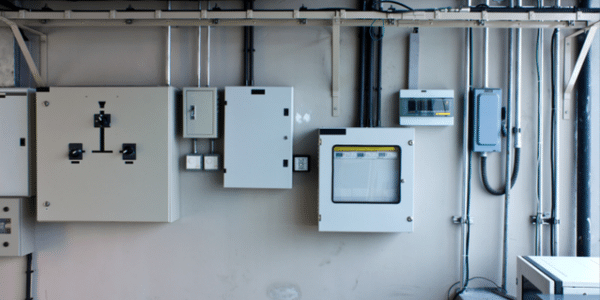The Impact of Moisture and Humidity on Electrical Fiberglass Boxes: Mitigation Strategies
6/26/20244 min read


Understanding the Vulnerabilities of Electrical Fiberglass Boxes
Electrical fiberglass boxes, widely used for their durability and non-conductive properties, exhibit certain vulnerabilities when exposed to moisture and humidity. The material composition of fiberglass, primarily a combination of glass fibers and resin, can be susceptible to moisture infiltration under specific conditions. When moisture permeates the fiberglass, it can lead to corrosion of internal metal components, degradation of the resin, and potential issues with electrical conductivity.
Several environmental factors significantly contribute to the elevated exposure of fiberglass boxes to moisture and humidity. Coastal areas, characterized by high humidity and saline air, pose a constant risk. Similarly, regions with high rainfall and fluctuating temperatures can exacerbate the moisture content within the boxes. Industrial environments, where exposure to chemical vapors and varying moisture levels is common, further amplify these vulnerabilities.
Recognizing the symptoms of moisture-related damage is crucial for timely intervention. One of the primary indicators is discoloration of the fiberglass surface, often manifesting as yellowing or darkening. This discoloration suggests prolonged exposure to moisture, potentially leading to further structural issues. Weakened structural integrity is another critical symptom; over time, the fiberglass may become brittle, reducing its ability to protect internal components effectively.
Compromised electrical performance is perhaps the most concerning consequence of moisture ingress. Electrical fiberglass boxes are designed to safeguard electrical systems from external elements. However, when moisture breaches the enclosure, it can lead to short circuits, increased electrical resistance, and ultimately, system failures. These issues not only pose safety risks but also result in costly repairs and downtime.
Understanding these vulnerabilities is the first step in mitigating the risks associated with moisture and humidity exposure. By identifying the environmental conditions that contribute to these problems and recognizing the early signs of damage, measures can be implemented to enhance the longevity and reliability of electrical fiberglass boxes in various settings.
Consequences of Moisture and Humidity on Electrical Systems
Moisture and humidity present significant risks to electrical systems, particularly those housed within fiberglass boxes. Moisture ingress can severely compromise the integrity of these systems, leading to short circuits, arcing, and potentially catastrophic fire hazards. When water or high humidity infiltrates electrical enclosures, it can cause conductive paths to form where they shouldn't, creating unintended connections and short circuits. This, in turn, can result in equipment malfunctions and failures.
Arcing, another dangerous consequence of moisture exposure, occurs when electricity jumps between connections through the air. This phenomenon can cause severe damage to electrical components and pose a substantial fire risk. Even minor arcing can degrade the performance of electrical systems over time, necessitating frequent maintenance and inspections.
The financial and operational impacts of moisture and humidity on electrical systems are profound. Increased maintenance costs are a direct consequence of the need to frequently inspect, clean, and repair affected components. System downtime is another critical issue, as unexpected equipment failures can halt operations, leading to significant productivity losses. Furthermore, the need for expensive replacements of damaged components or entire systems can strain financial resources.
Real-world case studies highlight the severity of these issues. For instance, a manufacturing plant experienced a substantial financial loss when moisture infiltrated its electrical control panels, causing widespread short circuits and downtime. The plant had to replace several key components, resulting in both direct financial costs and indirect costs due to lost productivity.
Proactive moisture management is thus essential to mitigate these risks. By implementing strategies such as sealing enclosures, using desiccants, and regularly monitoring humidity levels, businesses can protect their electrical systems from the detrimental effects of moisture and humidity. These measures not only enhance system reliability but also contribute to long-term cost savings and operational efficiency.
Effective Mitigation Strategies for Protecting Electrical Fiberglass Boxes
Ensuring the longevity and reliability of electrical fiberglass boxes in environments prone to moisture and humidity necessitates a multi-faceted approach. A key strategy involves the application of moisture-resistant coatings. These specialized coatings create a barrier that prevents water ingress and minimizes the risk of corrosion and electrical faults. Selecting high-quality, industry-standard coatings is crucial for optimal protection.
Proper sealing techniques are also fundamental in safeguarding electrical enclosures. Utilizing gaskets and seals made from durable, water-resistant materials can significantly reduce the penetration of moisture. These components should be regularly inspected and replaced as needed to maintain their efficacy. Careful attention to the sealing of entry points for cables and conduits is essential to prevent moisture bypass.
Incorporating desiccants and dehumidifiers within the enclosures can further mitigate moisture-related issues. Desiccants absorb ambient moisture, maintaining a dry internal environment, while dehumidifiers actively extract moisture from the air. These tools are particularly effective in closed or non-ventilated spaces where natural air circulation is limited.
Regular maintenance and inspections are critical in identifying and addressing potential vulnerabilities before they escalate. A comprehensive maintenance checklist should include visual inspections for signs of moisture ingress, testing of seals and gaskets, and verification of the functionality of desiccants and dehumidifiers. Proactive maintenance can prevent costly repairs and downtime.
Advanced solutions, such as the integration of smart sensors, offer real-time monitoring of moisture levels within electrical fiberglass boxes. These sensors can provide immediate alerts when moisture levels exceed safe thresholds, enabling prompt corrective actions. Furthermore, incorporating moisture barriers in the design phase of electrical enclosures adds an additional layer of protection, effectively insulating internal components from external humidity.
By implementing these mitigation strategies, the durability and performance of electrical fiberglass boxes can be significantly enhanced, ensuring their reliability in even the most challenging environments.
